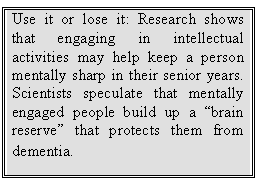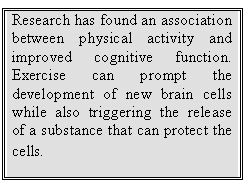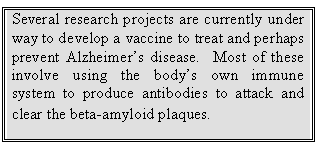PREVENTION OF DEMENTIA
Although the causes of dementia are not yet defined and there is currently no cure, there is growing evidence that certain measures can be taken that will postpone the onset of the disease and slow its progression.
“Use It or Lose It.” Research increasingly shows that engaging in intellectual activities may help keep a person mentally sharp in their senior years. The Nun Study carried out by researchers at the University of Kentucky examined the autobiographies of nearly 100 nuns written as young women (40). Those women who evidenced low linguistic ability in early life were found to be more likely to develop AD in later years. The Einstein Aging Study conducted by Verghese et al. studied the relationship between leisure activities and the risk of dementia in a prospective cohort of 469 subjects older than 75 years (41). Their findings, published in the New England Journal of Medicine in June 2003, showed that reading, playing cards or board games such as chess, checkers or Scrabble, and playing a musical instrument all correlated with a lower risk of developing dementia, both Alzheimer’s disease and vascular dementia. In addition, the more frequent the activity, the lower the risk.

Occupational history may also play a role in the development of dementia. Researchers at Case Western Reserve University School of Medicine studied the link between having a mentally demanding occupation and the later development of AD (42). They found that people in mentally challenging occupations in their thirties, forties, and fifties were less likely to develop AD. Scientists speculate that mentally engaged people build up a “brain reserve” that protects them from dementia. Intellectual activity causes the brain cells of these individuals to establish more complex connections that are more resistant to damage. They also suggest that mental stimulation may cause new brain cells to grow, delaying the onset of dementia’s symptoms (43).
Cardiovascular Risk Factors. According to Marilyn Albert, a Johns Hopkins University researcher with the Alzheimer’s Association, “If you do things that are good for your heart, they’ll be good for your brain” (44). Scientists are finding evidence that being physically active, having good cholesterol, maintaining a healthy weight, and controlling blood pressure can lower the risk of developing dementia as well as heart disease.
Two separate studies published in the Journal of the American Medical Association in September 2004 found an association between physical activity and better cognitive function in older adults. Research suggests that physical exercise can prompt the development of new brain cells while also triggering the release of a substance that can protect the cells (45). In the Honolulu-Asia Aging Study, 2,257 physically capable men aged 71 to 93 were assessed over eight years to determine if walking is associated with the risk of developing dementia. Abbott et al. found that the men who walked the least (<0.25 mile/day) had a 1.8-fold excess risk of developing dementia as compared with men who walked more than two miles per day (46). Men who walked from 0.25 to one mile per day were 1.7 times more likely than the more active men to develop dementia.

Using data from 18,766 women aged 70 to 81 years who participated in the Nurses’ Health Study, Harvard researchers Weuve et al. also found a positive association between physical activity and better cognitive performance. Women who walked at least 1.5 hours per week had less cognitive decline than those who walked less than 40 minutes per week (46).
Three studies presented at the 9 th International Conference on Alzheimer’s Disease and Related Disorders held in July 2004 examined other known cardiovascular risk factors and their links to dementia. Harvard researchers involved in the ongoing Women’s Health Study assessed more than 4,000 women aged 65 and older over several years and found that those women with the highest HDL, or “good,” cholesterol were less likely to develop AD (47). Women whose HDL levels were in the 60 to 75 mg/dL range decreased their risk of dementia by almost 50%.
In a study conducted by Khachaturian et al. of Johns Hopkins University School of Medicine, data from a three-year memory and aging study involving 3,300 participants aged 65 and older were analyzed to determine the relationship between blood pressure and the risk of AD. A lower Alzheimer’s risk was found among users of all hypertension medications; however, the risk reduction varied by type of medication. While use of any blood pressure medication lowered risk by 36%, diuretics were associated with an overall 40% risk reduction and users of a class of diuretic called potassium-sparing experienced a 75% reduction in Alzheimer’s risk (48).
Another finding, presented by University of Washington researcher Suzanne Craft, concerned Avandia, an oral diabetes medication, and memory. Avandia was found to improve memory and thinking ability in people with mild AD (48). Craft theorizes that Avandia works because it reduces a person’s insulin resistance, which in turn lowers levels of beta-amyloid protein in the blood, the protein found in plaques in the brains of AD patients.
You Are What You Eat. Diet is being increasingly studied in terms of how what we eat influences our risk of developing dementia. A Finnish study presented at the 9 th ICAD linked obesity with an increased risk of developing dementia. Dr. Mila Kivipelto’s study included 1,449 Finns whose BMI was calculated when they were in middle age and who were then reexamined an average of 21 years later (49). She found that the risk of any dementia, but AD in particular, doubled with a BMI of 30 or greater (obese).

One of the first studies to link specific foods and AD was conducted by researcher William Grant, who analyzed data from 18 different studies involving populations of people aged 65 and older in 11 countries. Dr. Grant’s study, “Dietary Links to Alzheimer’s Disease,” concluded that high fat and high calorie diets have a direct association with high AD prevalence rates (50). He also found that fish consumption reduced the incidence of AD in North America and Europe. A study at Chicago’s Rush-Presbyterian-St. Luke’s Medical Center involving 815 elderly Chicago residents found that the study participants who ate large quantities of polyunsaturated fats (found in vegetables and nuts) experienced a 70% reduction in the risk of developing AD compared with those who ate small amounts (51). Those people who ate large quantities of saturated (animal-based) fats, on the other hand, had double the risk of AD compared with people who ate small amounts.
Other scientists have determined that a diet high in the omega-3 fatty acid DHA (docosahexaenoic acid) that is found in cold water fish such as salmon, halibut, and tuna can help protect the brain against the cell damage caused by AD. A UCLA study used genetically modified mice that developed brain lesions similar to those found in advanced AD to study the effects of diet on the brain cells (52). Those mice fed a diet high in the omega-3 fatty acid DHA did not suffer the memory loss or cognitive damage evidenced by the mice whose diets did not include the supplement. According to Dr. Greg Cole, the study’s senior author, “This is the first proof that our diets affect how our brain cells communicate with each other under the duress of Alzheimer’s.” Researchers in the Chicago study noted above also found a positive association between eating fish at least once a week and a lowered risk of AD (51).
Data are more inconsistent on the effects of antioxidants such as beta carotene and vitamins C and E on the risk of dementia. Antioxidants combat free radicals, or charged particles, that are generated by normal metabolism but can over time damage cells, including neurons, and thus contribute to dementia. Scientists have been hopeful that taking antioxidant supplements or eating a diet rich in antioxidants could help prevent dementia. The results of studies to date, however, have been mixed. Scientists in the Netherlands conducted the Rotterdam Study, a population-based, prospective cohort study, following 5,395 participants aged 55 and older for ten years, and examining their diets over the duration. The study’s authors found that a high dietary intake of vitamins C and E was associated with a lower risk of AD, a relationship most pronounced among smokers (53). Similarly, researchers at Chicago’s Rush-Presbyterian-St. Luke’s Medical Center found separate, positive relationships between dietary vitamin E intake and dietary niacin and a lowered risk of Alzheimer’s (54). However, no association was found in the Chicago study between intake of vitamin C, beta carotene, and vitamin E from supplements and risk of AD.
Scientists analyzing data from the Cache County Study, a prospective study of 4,740 elderly (65 and older) participants in Cache County, Utah, found that use of vitamin C and E supplements in combination was associated with reduced AD prevalence and incidence (55). They found no evidence, however, of reduced risk with vitamin E or C supplements alone, with multivitamins alone, or with vitamin B-complex supplements. A fourth study, of 980 elderly Medicare patients in New York, found no evidence of a decreased risk of AD with any form of antioxidant intake (56).
Researchers at the Children’s Hospital and Research Center in California have published a 2004 study suggesting that iron deficiency may lead to the destruction of brain cells and progressive dementia (57). According to their research, when too little heme, a form of iron, is present in brain cells, the cells respond by overproducing the substance, which then reacts with oxygen to produce free radicals that cause the cell damage. The study’s authors recommend sufficient iron as a way to slow down or delay the onset of dementia.
NSAIDS. The possibility that inflammation in the brain plays a role in the development of AD has led scientists to study the effect of NSAIDs (nonsteroidal anti-inflammatory drugs) on the risk of dementia. Szekely et al. conducted a meta-analysis of published studies on exposure to nonaspirin NSAIDs and the risk of AD. Eleven studies met the criteria for inclusion. In all, both prospective and nonprospective, NSAID exposure was associated with a decreased risk of developing AD (58). The duration of NSAID use was found to be important in the Rotterdam study (59). No statistically significant findings resulted from use of less than 24 months, while taking an NSAID for 24 months or longer resulted in a likelihood of developing AD that was only 20% of that for non-users. Since NSAIDs can cause gastrointestinal bleeding, safe dosage and duration have yet to be determined.
Hormone Use. Contradictory evidence has been found in studies on the effect of the hormone estrogen on AD development in older women. Several pre-2000 studies found a positive association between taking estrogen supplements and a decreased risk of AD (60). Data from the Women’s Health Initiative Memory Study found just the opposite effect, however, i.e., an actual increase in the risk of dementia among postmenopausal-aged women among those participants taking estrogen plus progestin (61,62). More research is necessary to determine how estrogen therapy affects AD.
Scientists have recently turned their attention to the link between testosterone levels and AD risk. Laboratory models have shown that testosterone reduces the formation of both beta-amyloid plaques and tau protein (63). Moffat et al. studied data on 574 men participating in the Baltimore Longitudinal Study for a mean of 19.1 years and found that free testosterone concentrations (but not testosterone bound to sex hormone binding globulin) were lower in men who developed AD (64). Additional research is required to determine whether free testosterone levels offer protection against AD in older men.
Lithium. A small study presented at the 9 th ICAD linked lithium, a common treatment for bipolar disorder, with a decreased risk of AD. Nunes et al., from the University of Sao Paolo, Brazil, found that within their study population of 74 elderly individuals with bipolar disorder, 4% of those who had been taking lithium had AD, compared with 21% of patients not taking the drug (65). A Japanese team of scientists reported at the same conference that they had found decreased tau protein tangles in the brains of mice genetically altered to have AD that had been treated with lithium (65). Lithium also stopped the development of plaques in those mice. Research is ongoing to determine the mechanism by which the drug prevents or destroys the hallmark plaques and tangles of AD.
 Vaccine. Several
research projects are currently under way to develop a vaccine to treat
and perhaps prevent Alzheimer’s disease. Most research centers
around using the body’s own immune system to generate antibodies
to attack and clear the beta-amyloid plaques found in the brains of
AD patients. An experimental drug tested on 300 human subjects in 2000-2001
slowed memory decline, but clinical trials were halted when 18 participants
developed brain inflammation (66). When the brain of a woman who had
taken the vaccine and died after a fall was examined, scientists found
fewer plaques but also T cells, which are not normally found in the
brain, signaling that an overreaction of the immune system caused the
inflammation.
Vaccine. Several
research projects are currently under way to develop a vaccine to treat
and perhaps prevent Alzheimer’s disease. Most research centers
around using the body’s own immune system to generate antibodies
to attack and clear the beta-amyloid plaques found in the brains of
AD patients. An experimental drug tested on 300 human subjects in 2000-2001
slowed memory decline, but clinical trials were halted when 18 participants
developed brain inflammation (66). When the brain of a woman who had
taken the vaccine and died after a fall was examined, scientists found
fewer plaques but also T cells, which are not normally found in the
brain, signaling that an overreaction of the immune system caused the
inflammation.
Other researchers are now pursuing the same general immune-system strategy using different formulations. A paper published in October 2004 in the Journal of Alzheimer’s Disease discusses a new oral vaccine treatment developed by researchers from the National Institute for Longevity Studies ( Japan) and the Harvard Institute of Medicine (67). According to lead author Hideo Hara, MD, “This new oral vaccine does not induce strong T cell immune reactions, and hence could reduce the side effect of such meningoencephalitis . . . This new therapy seems to be effective for prevention and treatment of Alzheimer’s disease.” Human trials had not been initiated at the time of this report’s publication.